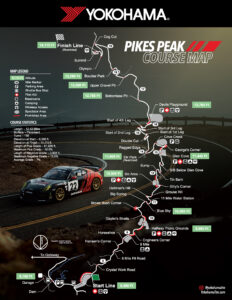The Pikes Peak International Hill Climb 
When Lt. Zebulon Pike first saw Pikes Peak rising abruptly from the Colorado plains in 1806, he swore that the mountain would ‘never be climbed by man.’ evidently he was wrong as it wasn’t just climbed, it was turned into a racetrack.
Nestled in the heart of the Rocky Mountains in Colorado, US of A, Pikes Peak stands as both an iconic symbol of natural beauty plus an annual feat of human endeavour. For it’s not just the mountain’s majestic presence that draws attention but the fact that it’s also the backdrop of an exhilarating race to its summit.
The Pikes Peak International Hill Climb, often referred to as the ‘Race to the Clouds,’ is a historic motorsport event that has captured the imagination of racing enthusiasts since 1916. It’s the second oldest auto race in the country, (after the Indianapolis 500) and every summer, competitors speed around 156 corners that begins at 9,390 feet and finishes at the 14,115-foot peak – a total distance of 12.4 miles.
The famous motorsport hill climb traces its roots back to the early 20th century, when in 1915 (having just finished converting the narrow carriage road into the Pikes Peak Highway) prominent Colorado Springs businessman Spencer Penrose, envisioned an event that would publicise his new road, draw visitors to his Broadmoor Hotel, and showcase the capabilities of automobiles – so he devised an automobile race to the summit of Pikes Peak.
The inaugural race took place on August 10-12, 1916, attracting a small group of daring drivers. Rea Lentz was crowned the winner in a time of 20:55.600, it was an upset victory as Lentz was driving a homemade car.
In these early years, the road was largely unpaved, presenting drivers with treacherous conditions, however, despite the challenges, the race continued, gradually gaining popularity.
The race faced a hiatus during World War II, but then resumed with renewed vigour with the 1940s and 1950s seeing the ascent of skilled drivers and innovative vehicles. However, the absence of proper road maintenance continued to make the race a demanding test of both driver and machine.
The 1960s marked a significant turning point as the road was finally fully paved, thus transforming the nature of the competition, and then the advent of improved road surfaces in the 1970s led
to a surge in interest from both competitors and spectators. The 1970s also witnessed the rise of turbocharging and advanced aerodynamics, enabling drivers to set increasingly impressive records.
The 1980s brought about the introduction of specialised vehicles built solely for the hill climb, setting the stage for an era of record-breaking runs, then NZ’s very own Rhys Millen’s stunning sub-11-minute run (10:04.060) in 1994, driving a purpose-built Toyota Supra, underscored the event’s growing prestige.
The 21st century ushered in an era of cutting-edge technology and heightened safety measures, and the Pikes Peak Hill Climb continued to attract top-tier drivers and international attention. However, the event also faced new challenges, including the need to balance performance with environmental concerns. In response, the race shifted to emphasise the importance of sustainable practices and alternative fuel sources.
As the Hill Climb entered the 2020s, it found itself at a crossroads between tradition and innovation. Electric vehicles, with their rapid acceleration and environmental benefits, began to dominate the headlines. The race witnessed the dawn of a new era in 2018 when Romain Dumas shattered the previous record with an all-electric VW prototype, conquering the peak in just 7:57.148. This achievement opened the door to new possibilities and reignited discussions about the future of motorsport.
Beyond the thrill of breaking records and conquering a challenging course, the Pikes Peak International Hill Climb stands as a testament to human determination, technological progress, and the enduring love for speed. It celebrates the spirit of adventure, pushing the boundaries of what is possible while respecting the beauty of the natural world. The race’s legacy is etched into the annals of motorsport history, inspiring generations of drivers, engineers, and enthusiasts to strive for greatness.
The Pikes Peak International Hill Climb is a saga that spans over a century, intertwining the evolution of technology with the indomitable human spirit. From its humble beginnings on a rugged mountain road to its current status as an electrifying global event, it continues to capture hearts and minds as competitors yearn to ‘race to the clouds’.
Dave McLeod – Motoring Writer


